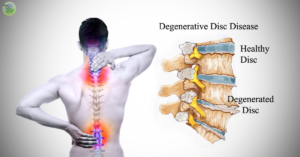Degenerative disc disease (DDD) is a common condition that affects the intervertebral discs of the spine, causing pain and discomfort for millions of people worldwide. While it’s not entirely reversible, there are numerous treatment options available to manage the symptoms and improve quality of life. In this guide, we’ll explore various approaches to treating degenerative disc disease, ranging from conservative methods to surgical interventions.

Understanding Degenerative Disc Disease: Degenerative disc disease is not actually a disease in the traditional sense but rather a natural part of the aging process. The intervertebral discs, which act as cushions between the vertebrae, undergo wear and tear over time, losing their flexibility, elasticity, and ability to absorb shock. This deterioration is primarily caused by:
Symptoms of Degenerative Disc Disease: The symptoms of degenerative disc disease vary from person to person and depend on the location and severity of disc degeneration. Common symptoms include:
Treatment Options:
1. Conservative Treatments:
– Physical Therapy: A tailored exercise program can strengthen the muscles supporting the spine, improve flexibility, and alleviate pressure on the affected discs.
– Pain Management: Over-the-counter or prescription medications, such as nonsteroidal anti-inflammatory drugs (NSAIDs) or muscle relaxants, can help manage pain and inflammation.
– Heat and Cold Therapy: Applying heat packs or cold compresses to the affected area may provide temporary relief from discomfort.
– Lifestyle Modifications: Maintaining a healthy weight, practicing good posture, and avoiding activities that exacerbate symptoms can help prevent further degeneration.
2. Interventional Treatments:
– Epidural Steroid Injections: Injecting corticosteroids into the epidural space around the spinal cord can reduce inflammation and alleviate pain.
– Facet Joint Injections: Targeted injections into the facet joints, which connect the vertebrae, can provide relief by blocking pain signals.
– Radiofrequency Ablation: This minimally invasive procedure uses heat to disrupt the nerves responsible for transmitting pain signals from the affected area.
3. Surgical Options:
– Discectomy: In cases where conservative treatments fail to provide relief, a discectomy may be recommended to remove the damaged portion of the disc and relieve pressure on surrounding nerves.
– Spinal Fusion: This procedure involves fusing two or more vertebrae together to stabilize the spine and reduce pain caused by motion between degenerated discs.
– Artificial Disc Replacement: An alternative to spinal fusion, artificial disc replacement involves removing the damaged disc and replacing it with an artificial implant to preserve motion in the spine.
At the Spine and Performance Institute, Dr Sharan has pioneered an innovative technique to perform surgery called Awake Spinal Fusion. This technique utilizes local and regional anesthesia, and allows patients to go home the same day.
Conclusion:
Managing degenerative disc disease requires a multidisciplinary approach tailored to the individual needs of each patient. While there’s no one-size-fits-all solution, a combination of conservative treatments, interventional therapies, and surgical interventions can help alleviate pain, improve mobility, and enhance overall quality of life for those living with this condition. It’s essential to work closely with healthcare providers to develop a comprehensive treatment plan that addresses both the symptoms and underlying causes of degenerative disc disease.
Stay Up to Date on News and Education
Copyright Spine Performance Institute 2023 | Privacy Policy